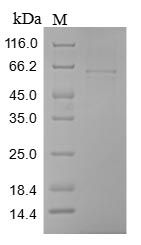Recombinant Human Cartilage intermediate layer protein 1 (CILP) is produced through a baculovirus expression system, covering amino acids 725-1184. The protein comes with an N-terminal 10xHis tag and a C-terminal Myc tag for easier detection and purification. This partial protein shows greater than 85% purity when analyzed by SDS-PAGE, which appears to make it appropriate for research applications requiring high-quality protein samples.
Cartilage intermediate layer protein 1 (CILP) is mainly known for its role in cartilage's extracellular matrix. The protein seems to be involved in how cartilage develops and maintains itself, likely playing an important part in keeping the tissue structurally sound and functional. Because CILP participates in cartilage biology, it has become a key target for researchers trying to understand cartilage-related processes and diseases.
Potential Applications
Note: The applications listed below are based on what we know about this protein's biological functions, published research, and experience from experts in the field. However, we haven't fully tested all of these applications ourselves yet. We'd recommend running some preliminary tests first to make sure they work for your specific research goals.
1. Antibody Development and Validation Studies
This recombinant CILP fragment serves as an excellent immunogen for generating antibodies specific to the domain 725-1184aa of human CILP. The dual tags facilitate efficient purification and screening. Even if the fragment is misfolded, it will generate antibodies against linear epitopes useful for Western blotting. If correctly folded, it may also produce antibodies recognizing conformational epitopes on the native protein in cartilage tissues.
2. Protein-Protein Interaction Studies
This application is highly dependent on correct folding. If properly folded, this recombinant CILP protein could identify physiological binding partners in the cartilage extracellular matrix. However, if misfolded, it may yield non-specific (false-positive) interactions or fail to bind genuine partners, making data interpretation unreliable without independent confirmation of its native structure.
3. ELISA-Based Quantification Assays
This CILP protein is well-suited as a standard for developing quantitative ELISA assays. It can be used to generate calibration curves for measuring CILP levels in biological samples like synovial fluid. The accuracy of the quantification depends on the antibody's specificity, not necessarily on the native folding of the standard protein.
4. Biochemical Characterization and Stability Studies
This application is the essential first step to determine the protein's folding state and biophysical properties. Techniques like size-exclusion chromatography (SEC) and circular dichroism (CD) can assess its oligomeric state, homogeneity, and structural integrity, providing critical data on whether the protein is correctly folded. These studies are fundamental for understanding the protein's physical state. The outcomes determine the suitability of this protein for all other structure-dependent applications.
Final Recommendation & Action Plan
The unknown folding state is the critical factor determining the protein's utility. The immediate and mandatory first step is Application 4 (Biochemical Characterization) to assess folding quality through SEC and CD analysis. If the protein is correctly folded and monodisperse, it may be considered for Application 2 (Interaction Studies), though functional validation would still be advisable. Regardless of the folding state, Applications 1 and 3 (Antibody Development and ELISA) can proceed confidently as they don't require native structure. Investing in interaction studies before folding validation is high-risk and likely to generate unreliable data.






